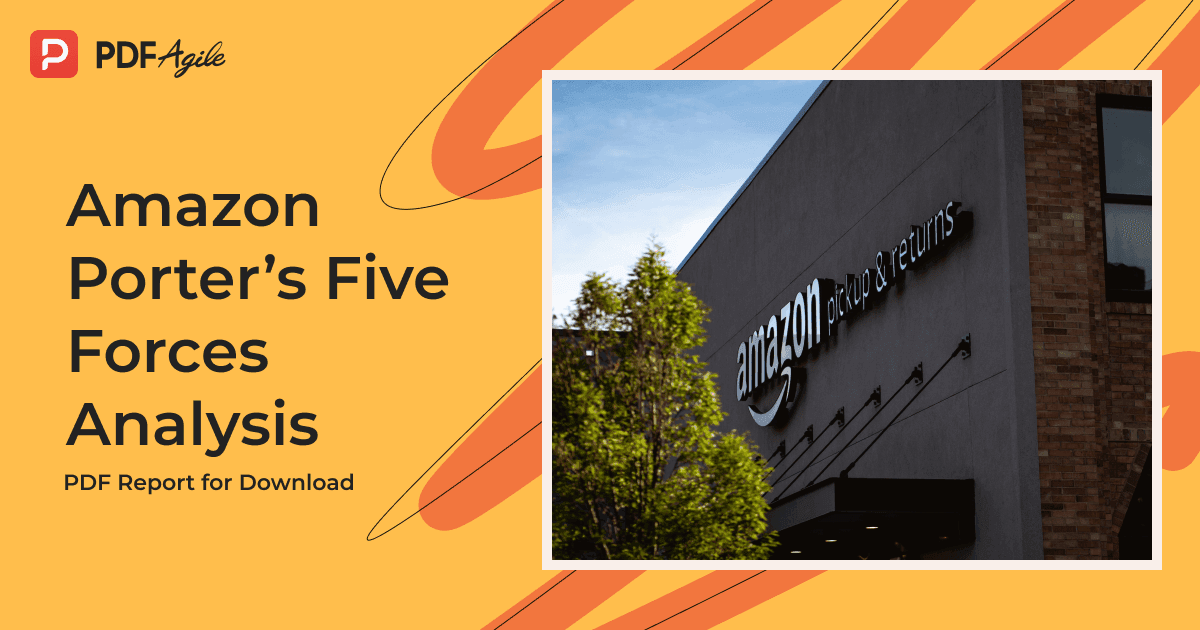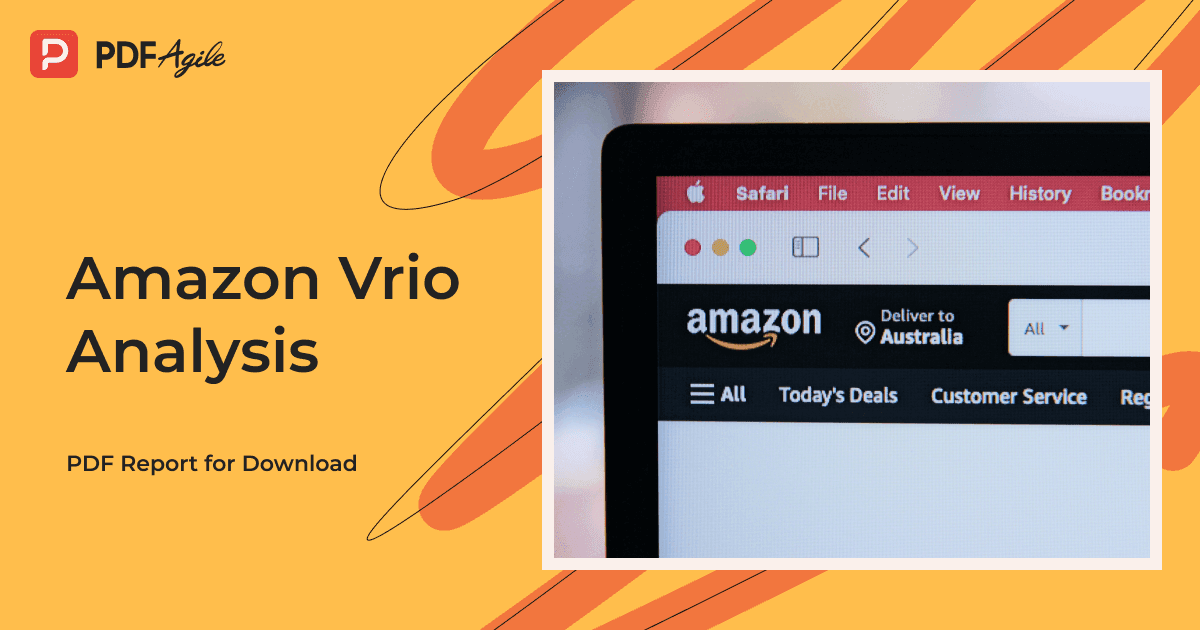When the areas of strengths and weaknesses are identified in an organization’s current competitive position in a specific industry, developing corporate strategies in favor of that organization becomes easy. Here is Amazon Porter’s five forces analysis that has primarily contributed to the overall success of Amazon's eCommerce retail business.
Porter’s five forces is an analytical model that explains the five competitive forces and how they shape competition in every industry. Business organizations use this model to identify and understand factors affecting profit margin in a specific sector, which helps in decision-making relating to marketing strategies, expansion in a particular industry, whether to enter a specific industry and much more.
Background of Amazon
Amazon, a giant in the retail e-commerce industry, was founded in 1994 by Jeff Bezos in Seattle, Washington. Initially, Amazon operated as an online bookstore but later expanded into selling a wide range of products and services such as electronics, housewares, toys, food, music, cloud services, and many more.
Over time, Amazon has gradually grown and is now operating in different countries using different websites globally. As per Amazon industry analysis, it is among the most significant information technology companies worldwide, alongside Apple, Microsoft, and Google.

Image source: www.unsplash.com
Amazon Porter’s Five Forces
Apart from offering good customer care services and growth in technology, insights from Amazon Porter’s five forces have contributed significantly to the revolution of Amazon in the e-commerce industry. In this Amazon industry analysis, we will see how the five forces have helped Amazon predict shifts in competition, understand how the industry structure evolves, and find a strategic position in the e-commerce industry.

Competition in the Industry (Strong Force)
Amazon competitors' analysis shows that the level of competition in the e-commerce industry is intensifying rapidly. Here are some of the factors intensifying rivalry in the retail e-commerce industry:
- Rate of Growth of the Industry – In recent years, many players have risen, with some physical retailers like Walmart offering selling online. Given the aggressiveness of retail businesses, it poses a solid challenge to Amazon in maintaining and increasing the profit margin and market share.
- Diversity of competitors – In the e-commerce retail industry, different organizations have strategically positioned themselves differently, with some operating both physically and online like Walmart. In contrast, others provide a wide range of products and services like Amazon, which intensifies rivalry among competitors.
The Threats of the New Entrants (Weak Force)
Being a large-scale company, Amazon has been registering huge profits annually, which has attracted new entrants in the industry affecting the competition pattern in the industry. The threats of new entrants depend on the following factors:
- Economies of Scale – With a high-profit margin and a significant market share in the e-commerce industry, Amazon enjoys high economies of scale, strengthening the giant retail business. New entrants can quickly adapt to Amazon’s business model but cannot enjoy economies of scale at the same level as Amazon, which is a barrier to the new entrants.
- Capital Requirements – Amazon is an established brand image that has invested heavily in marketing, warehousing, logistics, customer service, delivery facilities, etc., which poses a financial challenge to the new entrants, making it hard for them to rise to the Amazon's marketing level.
The Bargaining Power of Suppliers (Moderate Force)
The bargaining power of suppliers is a moderate force of Amazon Porter’s five forces. Below are some of the factors. The bargaining power of suppliers has a direct impact on prices and profits. Here are some of the factors affecting the supplier's bargaining power:
- Differentiation of Products Provided by Suppliers – Certain suppliers may have differentiated products and services, which gives them monopoly power in the market. However, the differentiation of products provided by suppliers can moderately affect Amazon since it already has a significant market share in the e-commerce industry.
- Importance of Volume to Supplier – Every supplier values selling a high volume of products all at once, and Amazon can purchase a large volume of products from its suppliers. No supplier would wish to lose a bulk buyer like Amazon, which moderately limits suppliers' bargaining power.
The Bargaining Power of Customers (Strong Force)
The bargaining power of customers determines the extent of their impact on prices and the quality of products and services in the industry. The below factors determine the bargaining power of Amazon customers:
- Information About Products and Services – Customers can access first-hand information regarding the type of products offered by different online retailers, making it easy for them to find alternatives.
- Customer’s Price Sensitivity – Informed buyers are susceptible to prices. When a new entrant has a way of providing the same products at a lower cost, customers are likely to shift from Amazon.
The Threat of Substitute Products or Services (Strong Force)
Amazon industry analysis shows that giving the best customer services builds customer loyalty, contributing significantly to maintaining the Amazon market share. However, this has not exempted Amazon from the threat of substitute products and services, as seen below:
- Perceived Level of Product Differentiation – Some suppliers are focused on differentiating their products, creating a level of uniqueness for their products. When such suppliers are not a part of Amazon's supply chain, customers will get that product from another retailer.
- Existence of close Substitutes – Despite being a giant retailer, Amazon sells the same products as other retailers, which gives customers an easy time to change from Amazon to other e-commerce or physical retailers.
Strategies of Success
Apart from Amazon Porter's Five Forces analysis, other strategies have contributed to the overall success of Amazon, as seen below:
- Cost Leadership – You can implement a Cost leadership strategy by offering a wide range of products and services, low prices, and convenient delivery. Though the profit margin may be low, it increases market share and competitive advantage.
- Differentiation – Differentiation in the market depends on the marketing strategies and the uniqueness of products and services. It takes creativity, innovations, and technology to stand out in a competitive industry like the retail e-commerce industry.
- Focus – It takes understanding the industry, competitors, suppliers, and customers to implement the focus strategy, which helps select a specific market segment.
Key Takeaways
According to Amazon's industry analysis, the giant retailer has an intense competitor's rivalry from the rapid growth of the retail e-commerce industry, the substantial threat of substitutes due to low switching costs, and the strong bargaining power of buyers due to their ability to gather information regarding products and services.
On the other hand, Amazon remains dominant over suppliers due to its ability to purchase a high volume of products which is an advantage to suppliers though it reduces their bargaining power. Also, porter’s five forces example Amazonanalysis shows how weak the threat of new entrants is due to the competitive advantage that Amazon has gained over time.
You can use PDF Agile to make and edit Amazon Porter’s Five Forces PDF template.
References
Marci Martin. 'How Porter's Five Forces Can Help Small Businesses Analyze the Competition,' Business News Daily, [online]. Available at: https://www.businessnewsdaily.com/5446-porters-five-forces.html (Accessed 19 May 2022)
Tony Rutakirwa. ‘ANALYSIS OF AMAZON MANAGEMENT AND ORGANIZATIONS,’ researchgate.net, [online]. Available at: https://www.researchgate.net/publication/335429756_ANALYSIS_OF_AMAZON_MANAGEMENT_AND_ORGANISATIONS (Accessed 19 May 2022)
Adamkasi. ‘Porter’s Five Forces Analysis of Amazon,’ Porter Analysis, [online]. Available at: https://www.porteranalysis.com/porters-five-forces-analysis-of-amazon/ (Accessed 19 May 2022)
MBA Skool Team. ‘Amazon Porter Five Forces Analysis,’ mba SKOOL, [online]. Available at: https://www.mbaskool.com/five-forces-analysis/companies/18304-amazon.html (Accessed 19 May 2022)





